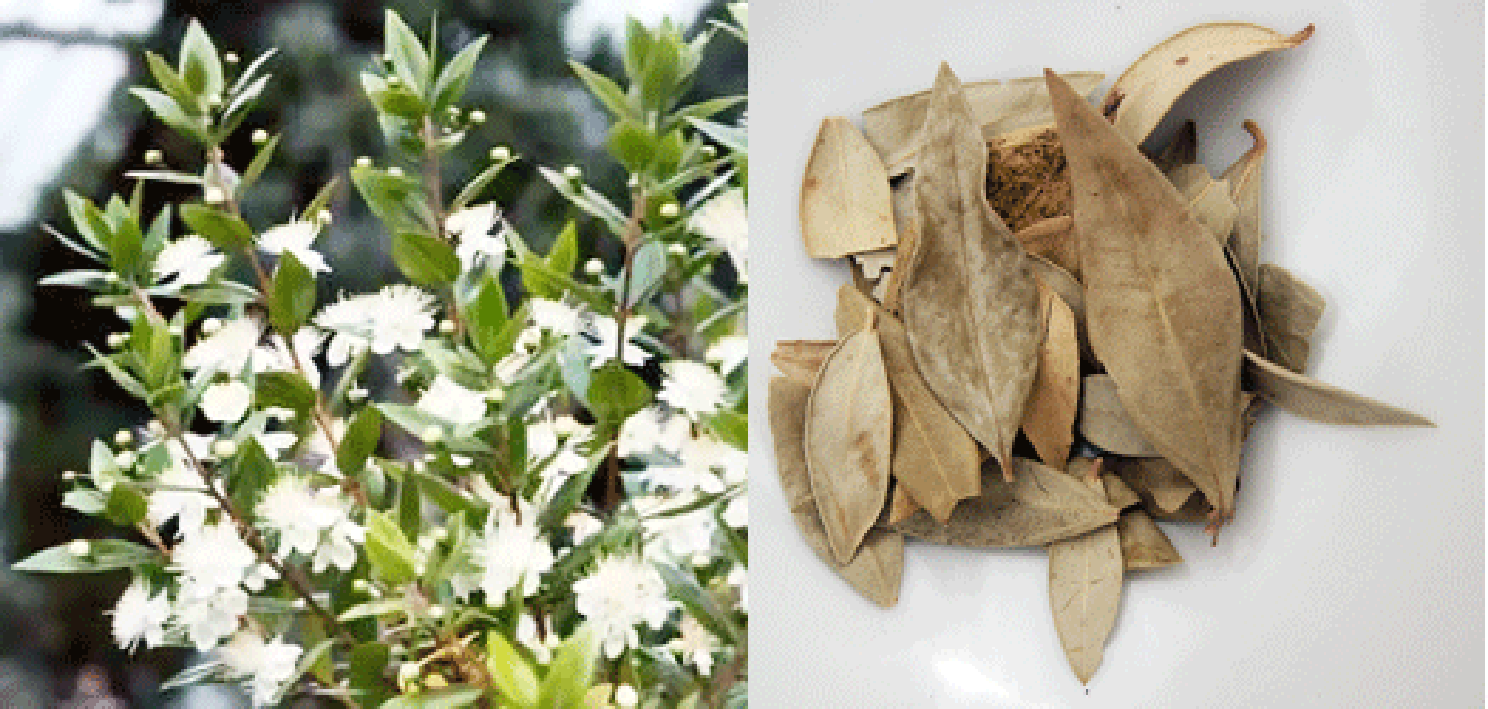 Myrtle Myrtus
communis bush
in flower and dried
myrtle leaves.
Myrtle Myrtus
communis bush
in flower and dried
myrtle leaves.
Welcome to the summary page for FabulousFusionFood's Herb guide to Myrtle along with all the Myrtle containing recipes presented on this site, with 15 recipes in total.
e This is a continuation of an entire series of pages that will, I hope, allow my visitors to better navigate this site. As well as displaying recipes by name, country and region of origin I am now planning a whole series of pages where recipes can be located by meal type and main ingredient. This page gives a listing of all the Cornish recipes added to this site.
These recipes, all contain Myrtle as a major herb flavouring.
Myrtle, Myrtus communis is a woody evergreen shrub in the Myrtaceae (myrtle, clove and eucalyptus) family which is native to Southern Europe and North Africa. The plants can grow up to 5m tall and produce a mass of leaves some 3–5 cm long that can be identified by their pleasant fragrance.
Both the dried and fresh leaves are used in Mediterranean cuisine and dried myrtle leaves can be easily bought in most European countries. The aroma of the leaves are slightly reminiscent of myrrh and eucalypt but the taste is very intense and extremely bitter. This is especially true of fresh leaves which are generally used to smoke meats by spreading them over the fire of a smoker. They can also impart a pleasant taste to barbecued meats by being repeatedly spread over the charcoal in a barbecue.
Dried myrtle leaves are much less intense in flavour and can be made into a rub for pork by being mixed with thyme leaves, rosemary leaves and peppercorns in a pestle and mortar before being ground together. This mixture can be rubbed into pork chops or pork joints before cooking.
In the past, it was used commonly as a wrapping or stuffing for clay-baked or pit-roasted meats and this way, it imparts an interesting flavour to the foods with none of the bitterness (most of the recipes given below are re-creations of ancient recipes using myrtle in this manner).
Like many other aromatic leaves (bay, eucalypt, allspice leaves, rosemary or thyme), myrtle branches (or even dried myrtle leaves) thrown on the hot coals of a barbecue impart a very interesting flavour to barbecued meats. Myrtle leaves also make an useful addition to the wood used in smokers.
e This is a continuation of an entire series of pages that will, I hope, allow my visitors to better navigate this site. As well as displaying recipes by name, country and region of origin I am now planning a whole series of pages where recipes can be located by meal type and main ingredient. This page gives a listing of all the Cornish recipes added to this site.
These recipes, all contain Myrtle as a major herb flavouring.
Myrtle, Myrtus communis is a woody evergreen shrub in the Myrtaceae (myrtle, clove and eucalyptus) family which is native to Southern Europe and North Africa. The plants can grow up to 5m tall and produce a mass of leaves some 3–5 cm long that can be identified by their pleasant fragrance.
Both the dried and fresh leaves are used in Mediterranean cuisine and dried myrtle leaves can be easily bought in most European countries. The aroma of the leaves are slightly reminiscent of myrrh and eucalypt but the taste is very intense and extremely bitter. This is especially true of fresh leaves which are generally used to smoke meats by spreading them over the fire of a smoker. They can also impart a pleasant taste to barbecued meats by being repeatedly spread over the charcoal in a barbecue.
Dried myrtle leaves are much less intense in flavour and can be made into a rub for pork by being mixed with thyme leaves, rosemary leaves and peppercorns in a pestle and mortar before being ground together. This mixture can be rubbed into pork chops or pork joints before cooking.
In the past, it was used commonly as a wrapping or stuffing for clay-baked or pit-roasted meats and this way, it imparts an interesting flavour to the foods with none of the bitterness (most of the recipes given below are re-creations of ancient recipes using myrtle in this manner).
Like many other aromatic leaves (bay, eucalypt, allspice leaves, rosemary or thyme), myrtle branches (or even dried myrtle leaves) thrown on the hot coals of a barbecue impart a very interesting flavour to barbecued meats. Myrtle leaves also make an useful addition to the wood used in smokers.
The alphabetical list of all Myrtle recipes on this site follows, (limited to 100 recipes per page). There are 15 recipes in total:
Page 1 of 1
| Aliter assaturas (Roast Meats, Another Way) Origin: Roman | Cocos Potiedig (Potted Cockles) Origin: Welsh | Ius in copadiis IV (Sauce for Choice Cuts IV) Origin: Roman |
| Aliter in Apro II (Wild Boar, Another Way II) Origin: Roman | Ffagod Traddodiadol (traditional Faggots) Origin: Welsh | Ius in Diversis Avibus (Sauce for Various Birds) Origin: Roman |
| Aliter ius candidum in copadiis (White Sauce for Choice Cuts, Another Way) Origin: Roman | Fresco de Arrayan Origin: El Salvador | Ius in Pisce Aurata (Sauce for Gilthead) Origin: Roman |
| Clay-baked Fish Origin: Ancient | In Perdice (Of Partridge) Origin: Roman | Ius in Pisce Aurata (Sauce for Gilthead Bream) Origin: Roman |
| Clay-baked Leg of Goat Origin: Britain | In perdice (Boiled Partridge) Origin: Roman | Vinum Murteum (Myrtle Wine) Origin: Roman |
Page 1 of 1